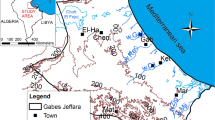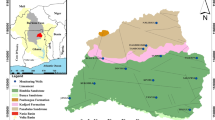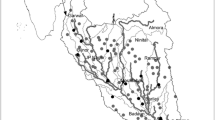Abstract
In the Apalachicola-Chattahoochee-Flint (ACF) river basin in Alabama, Georgia, and Florida (USA), population growth in the city of Atlanta and increased groundwater withdrawal for irrigation in southwest Georgia are greatly affecting the supply of freshwater to downstream regions. This study was conducted to understand and quantify the effect of irrigation pumpage on the karst Upper Floridan Aquifer and river–aquifer interactions in the lower ACF river basin in southwest Georgia. The groundwater MODular Finite-Element model (MODFE) was used for this study. The effect of two drought years, a moderate and a severe drought year, were simulated. Comparison of the results of the irrigated and non-irrigated scenarios showed that groundwater discharge to streams is a major outflow from the aquifer, and irrigation can cause as much as 10 % change in river–aquifer flux. The results also show that during months with high irrigation (e.g., June 2011), storage loss (34 %), the recharge and discharge from the upper semi-confining unit (30 %), and the river–aquifer flux (31 %) are the major water components contributing towards the impact of irrigation pumpage in the study area. A similar scenario plays out in many river basins throughout the world, especially in basins in which underlying karst aquifers are directly connected to a nearby stream. The study suggests that improved groundwater withdrawal strategies using climate forecasts needs to be developed in such a way that excessive withdrawals during droughts can be reduced to protect streams and river flows.
Résumé
Dans le bassin versant de l’Apalachicola-Chattahoochee-Flint (ACF) en Alabama, Georgia, et Floride (Etats-Unis d’Amérique), la croissance démographique dans la ville d’Atlanta et l’augmentation des prélèvements d’eau souterraine pour l’irrigation dans le Sud-Ouest de Georgia ont fortement affectés l’alimentation en eau potable dans les régions en amont. L’étude a été menée afin de comprendre et de quantifier l’effet des pompages pour l’irrigation sur l’aquifère karstique du Floridien supérieur et sur les interactions entre rivière et aquifère dans la partie inférieure du bassin versant ACF dans le Sud-Ouest de Georgia. Le modèle hydrogéologique à éléments finis MODular (MODFE) a été utilisé dans le cadre de cette étude. L’effet de deux années sèches, une année de sécheresse modérée et une année de sécheresse sévère, a été simulé. La comparaison des résultats pour des scénarios avec et sans irrigation ont montré que la décharge des eaux souterraines dans les cours d’eau est un flux principal de sortie de l’aquifère, et que l’irrigation peut causer jusqu’à 10 % de modification dans les flux d’échange entre la rivière et l’aquifère. Les résultats montrent également qu’au cours des mois avec une forte irrigation (ex. Juin 2011), les pertes d’emmagasinement (34 %), la recharge et la décharge de l’unité supérieure semi captive (30 %), et les flux d’échange entre la rivière et l’aquifère (31 %) sont les principales composantes qui contribuent à l’impact des pompages d’irrigation dans la zone d’étude. Un tel scénario prend place dans de nombreux bassins versants de par le monde, en particulier dans les bassins au sein desquels les aquifères karstiques sous-jacents sont directement connectés aux cours d’eau avoisinants. L’étude suggère que des stratégies de prélèvements d’eaux souterraines améliorés en utilisant des prévisions climatiques doivent être développées de telle manière à ce que les prélèvements excessifs pendant les sécheresses puissent être réduits afin de protéger les cours d’eau et les écoulements en rivière.
Resumen
En la cuenca del río Apalachicola-Chattahoochee-Flint (ACF) en Alabama, Georgia y Florida (EE.UU.), el crecimiento de la población en la ciudad de Atlanta y el aumento de extracción de agua subterránea para riego en el suroeste de Georgia están afectando en gran medida el suministro de agua dulce a las regiones aguas abajo. Este estudio se realizó para comprender y cuantificar el efecto del bombeo para riego en el acuífero kárstico superior de Florida y las interacciones río-acuífero de la cuenca baja del río ACF en el suroeste de Georgia. Se utilizó el modelo de agua subterránea modular de elementos finitos (MODFE) para este estudio. Se simularon el efecto de dos años de sequía, uno moderado y otro de sequía severa. La comparación de los resultados de los escenarios de regadío y de secano mostró que la descarga de agua subterránea a los arroyos es una salida importante del acuífero, y el riego puede causar hasta un 10 % de cambio en el flujo del río–acuífero. Los resultados también muestran que durante meses con alto riego (por ejemplo, de junio de 2011), la pérdida de almacenamiento (34 %), la recarga y descarga de la unidad semi-confinada superior (30 %), y el flujo río–acuífero (31 %) son las principales componentes de la contribución del agua al impacto del bombeo para riego en la zona de estudio. Un escenario similar se desarrolla en muchas cuencas de los ríos en todo el mundo, especialmente en las cuencas en las que subyacen los acuíferos kársticos y están conectados directamente a un arroyo cercano. El estudio sugiere que la mejora de las estrategias de extracción de agua subterránea utilizando los pronósticos del clima deben ser desarrollados de tal manera que el exceso de extracciones durante las sequías pueden reducirse para proteger los flujos y caudales de los ríos.
摘要
在(美国)阿拉巴马州、乔治亚州和佛罗里达州阿巴拉契科拉- 查特胡奇-弗林特流域,亚特兰大市人口增长和乔治亚州西南部日益增长的灌溉用地下水抽取严重影响了下游地区的淡水供应。进行这项研究就是为了了解和量化灌溉抽水对乔治亚州西南部阿巴拉契科拉- 查特胡奇-弗林特流域下游上佛罗里达系岩溶含水层和河流-含水层相互作用的影响。本研究采用了地下水模数有限元模型。模拟了两个干旱年份、分别为中等干旱和严重干旱年份的影响。灌溉和非灌溉方案结果的对比显示,地下水排泄到河流是含水层主要的流出方式,灌溉可导致差不多10%的河流–含水层通量变化。结果还显示,在灌溉高峰的月份里(例如6月),储存损耗量(34 %)、半承压单元上部的补给和排泄(30 %)及河流–含水层通量(31 %)是造成研究区内灌溉抽水影响的主要成分。类似的方案在全世界许多流域实施,特别是在下伏的岩溶含水层与附近的河流直接连通的流域更是如此。研究表明,采用气候预测所改进的地下水抽水对策需要以以下的方式开发,这就是减少干旱期间的过度开采,以保护河流的水流。
Resumo
Na bacia do rio Apalachicola-Chattahoochee-Flint (ACF) no Alabama, Geórgia e Flórida (EUA), o crescimento da população na cidade de Atlanta e o aumento da retirada de água subterrânea para irrigação no sudeste da Geórgia estão afetando muito o suprimento de água para regiões a jusante. Este estudo foi conduzido para entender e quantificar o efeito do bombeamento para irrigação no Aquífero Cárstico Floridan Superior e a interação rio–aquífero na bacia inferior do rio ACF no sudeste da Geórgia. Foi utilizado neste estudo de águas subterrânea o modelo de elementos finitos modular (MODFE). O efeito de dois anos de estiagem, um moderado e um ano de seca severa, foram simulados. A comparação de resultados de cenários irrigados e não irrigados mostraram que a descarga da água subterrânea para a drenagem é a principal saída do aquífero e a irrigação pode causar mais que 10 % de alteração no fluxo rio-aquífero. Os resultados mostraram que durante meses com irrigação elevada (Junho de 2011), a redução de armazenamento (34 %), a recarga e a descarga da unidade superior semiconfinada (30 %), e o fluxo rio–aquífero (31 %) são os principais componentes contribuindo para o impacto do bombeamento da irrigação na área de estudo. Um cenário semelhante se desenrola em muitas bacias hidrográficas em todo o mundo, especificamente nas bacias em que aquíferos cársticos subjacentes estão diretamente conectados ao rio próximo. O estudo sugere que a melhoria das estratégias de retirada de água subterrânea usando previsão climática necessita ser desenvolvida de tal forma que as retiradas excessivas durante a estiagem possam ser reduzida para proteger o fluxo em rios e córregos.









Similar content being viewed by others
References
Albertson P, Torak LJ (2002) Simulated effects of ground-water pumpage on stream–aquifer flow in the vicinity of federally protected species of freshwater mussels in the Lower Apalachicola-Chattahootchee-Flint River Basin (subarea 4), southeastern Alabama, northeastern Florida, and southwestern, Georgia. US Geol Surv Water Invest Rep 02–4016, 48 pp
Boulton AJ, Hancock PJ (2006) Rivers as groundwater-dependent ecosystems: a review of degrees of dependency, riverine processes and management implications. Aust J Bot 54:133–144. doi:10.1071/BT050740067-1924/06/020133
Bunn SE, Arthington AH (2002) Basic principles and ecological consequences of altered flow regimes for aquatic biodiversity. Environ Manag 30:492–507. doi:10.1007/s00267-002-2737-0
Chen XH, Shu L (2002) Stream–aquifer interactions: evaluation of depletion volume and residual effects from groundwater pumping. Ground Water 40(3):284–290
Chen XH, Yin Y (2001) Streamflow depletion: modeling of baseflow reduction and stream infiltration from seasonally pumped wells. J Am Water Resour Assoc 37(1):185–195
Chen C, Pei S, Jiao JJ (2003) Land subsidence caused by groundwater exploitation in Suzhou City, China. Hydrogeol J 11:275–287. doi:10.1007/s10040-002-0225-5
Cooley RL (1983) Analysis of an incongruity in the standard Galerkin finite-element method. Water Resour Res 19(1):289–291
Cooley RL (1992) A MODular Finite-Element model (MODFE) for areal and axisymmetric ground-water flow problems, part 2: derivation of finite-element equations and comparisons with analytical solutions. US Geol Surv Techniques of Water-Resources Investigations, Book 6, Chap. A4, USGS, Reston, VA, 108 pp
Georgia Department of Natural Resources Environmental Protection Division (2006) Flint River Basin regional water development and conservation plan. https://epd.georgia.gov/sites/epd.georgia.gov/files/related_files/site_page/Plan22.pdf. Accessed 12 January 2016
Georgia Legislative Assembly (2014) Flint River Drought Protection Act. http://www.legis.ga.gov/legislation/en-US/display/20132014/SB/213. Accessed 12 January 2016
Glennon RJ (2002) Water follies: groundwater pumping and the fate of America’s fresh waters. Island, Washington DC, 314 pp
Golladay SW, Gagon P, Kearns M, Battle JM, Hicks DW (2004) Response of freshwater mussel assemblages (Bivalvia:Unionidae) to record drought in the Gulf Coastal Plain of southwest Georgia. J N Am Benthol Soc 23:494–506
Hayes LR, Maslia ML, Meeks WC (1983) Hydrology and model evaluation of the principal artesian aquifer, Dougherty Plain, southwest Georgia. Georgia Geol Surv Bull 97, 93 pp
Hicks DW, Gill HE, Longsworth SA (1987) Hydrogeology, chemical quality, and availability of ground water in the Upper Floridan aquifer, Albany, Georgia. US Geol Surv Sci Invest Rep 87-4145, 52 pp
Jones LE, Torak LJ (2006) Simulated effects of seasonal ground-water pumpage for irrigation on hydrologic conditions in the lower Apalachicola–Chattahoochee–Flint River Basin, southwestern Georgia and parts of Alabama and Florida, 1999–2002. US Geol Surv Sci Invest Rep 2006-5234, 115 pp. http://pubs.usgs.gov/sir/2006/5234/. Accessed 12 January 2016
Kinnaman SL, Dixon JF (2011) Potentiometric surface of the Upper Floridan aquifer in Florida and parts of Georgia, South Carolina, and Alabama, May–June 2010. US Geol Surv Sci Invest Map 3182, 1 sheet
Mitra S, Srivastava P, Singh S, Yates D (2014) Effect of ENSO-induced climate variability on groundwater levels in the lower Apalachicola-Chattahoochee-Flint river basin. Trans ASABE 57(5):1393–1403
Peterson J, Wisniewski J, Shea C, Jackson CR (2011) Estimation of mussel population response to hydrologic alteration in a southeastern U.S. stream. J Environ Manag 48:109–122. 10.1007/s00267-011-9688-2
Poole GC, Stanford JA, Running SW, Frissell CA (2006) Multiscale geomorphic drivers of groundwater flow paths: subsurface hydrologic dynamics and hyporheic habitat diversity. J N Am Benthol Soc 25:288–303
Postel S (1997) Last oasis: facing water scarcity. Norton, New York, 239 pp
Postel S (1999) Pillar of sand: can the irrigation miracle last? Norton, New York, 313 pp
Pringle CM, Triska FJ (2000) Emergent biological patterns and surface-subsurface interactions at landscape scales. In: Jones JB, Mulholland PJ (eds) Stream and groundwaters. Academic, San Diego, pp 167–193
Rugel K, Golladay SW (2016) Jackson CR, Rasmussen TC (2016) Delineating groundwater/surface water interaction in a karst watershed: lower Flint River Basin, southwestern Georgia USA. J Hydrol: Reg Stud 5:1–19
Rugel K, Romeis J, Jackson CR, Golladay SW, Hicks DW, Dowd JF (2009) Use of historic data to evaluate effects of pumping stress on streams in southwest Georgia. Proceedings of the 2009 Georgia Water Resources Conference, April 27–29, 2009, University of Georgia, Athens, GA
Rugel K, Jackson CR, Romeis JJ, Golladay SW, Hicks DW, Dowd JF (2012) Effects of irrigation withdrawals on streamflows in a karst environment: lower Flint River Basin, Georgia, USA. Hydrol Process. doi:10.1002/hyp.8149
Shi XQ, Xue YQ, Ye SJ, Wu JC, Zhang Y, Yu J (2007) Characterization of land subsidence induced by groundwater withdrawals in Su-Xi-Chang area, China. Environ Geol 52:27–40. doi:10.1007/s00254-006-0446-3123
Siebert S, Burke J, Faures JM, Frenken K, Hoogeveen J, Doll P, Portmann FT (2010) Groundwater use for irrigation: a global inventory. Hydrol Earth Syst Sci 14:1863–1880
Singh S, Srivastava P, Abebe A, Mitra S (2015) Baseflow response to climate variability induced droughts in the Apalachicola–Chattahoochee–Flint River Basin, U.S.A. J Hydrol 528(2015):550–561
Sophocleous M (2002) Interactions between groundwater and surface water: the state of the science. Hydrogeol J 10:52–67. doi:10.1007/s10040-001-0170-8
Southern Environmental Law Center (2013) Tri-state water wars (AL, GA, FL). https://www.southernenvironment.org/cases-and-projects/tri-state-water-wars-al-ga-fl. Accessed 17 October 2015
Stanford JA, Ward JV (1993) An ecosystem perspective of alluvial rivers: connectivity and the hyporheic corridor. J N Am Benthol Soc 12:48–60
Sterrett SC, Smith LL, Golladay SW, Schweitzer SH, Maerz JC (2011) The conservation implications of riparian land use on river turtles. Anim Conserv 14:38–46. doi:10.1111/j.1469-1795.2010.00394.x
Stromberg JC, Tiller R, Richter B (1996) Effects of groundwater decline on riparian vegetation of semiarid regions: the San Pedro, Arizona. Ecol Appl 6:113–131
Tarhule A, Woo M (1997) Characteristics and use of shallow wells in a stream fadama: a case study in northern Nigeria. Appl Geogr 17(1):29–42
Torak LJ (1993a) A MODular Finite-Element model (MODFE) for areal and axisymmetric ground-water flow problems, part 1: model description and user’s manual. US Geological Survey Techniques of Water-Resources Investigations, Book 6, Chap. A3, USGS, Reston, VA, 136 pp
Torak LJ (1993b) A MODular Finite-Element model (MODFE) for areal and axisymmetric ground-water flow problems, part 3: design philosophy and programming details. US Geological Survey Techniques of Water-Resources Investigations, Book 6, Chap. A5, USGS, Reston, VA, 243 pp
Torak LJ, Painter JA (2006) Geohydrology of the lower Apalachicola–Chattahoochee–Flint River Basin, southwestern Georgia, northwestern Florida, and southeastern Alabama. US Geol Surv Sci Invest Rep 2006-5070, 80 pp
VanLooy JA, Martin CW (2005) Channel and vegetation changes on the Cimarron River, southwestern Kansas, 1953–2001. Ann Am Assoc Am Geogr 95:727–739. doi:10.1111/j.1467-8306.2005.00483.x
Winter TC, Harvey JW, Franke OL, Alley WM (1998) Ground water and surface water: a single resource. US Geol Surv Circ 1139, Denver, 4 pp
Zektser S, Loaiciga HA, Wolf JT (2005) Environmental impacts of groundwater overdraft: selected case studies in the southwestern United States. Environ Geol 47:396–404. doi:10.1007/s00254-004-1164-3
Zienkiewicz OC (1977) The finite element method. McGraw-Hill, New York, 787 pp
Zume J, Tarhule A (2008) Simulating the impacts of groundwater pumping on stream–aquifer dynamics in semiarid northwestern Oklahoma, USA. Hydrogeol J 16:797–810. doi:10.1007/s10040-007-0268-8
Acknowledgements
The authors are grateful to Mr. Lynn Torak whose comments helped to greatly improve this manuscript. The authors wish to acknowledge funding provided by the National Integrated Drought Information System (NIDIS), the National Oceanic and Atmospheric Administration (NOAA) Sectoral Applications Research Program (SARP), and the NOAA Regional Integrated Sciences and Assessments (RISA) Program for this research.
Author information
Authors and Affiliations
Corresponding author
Rights and permissions
About this article
Cite this article
Mitra, S., Srivastava, P. & Singh, S. Effect of irrigation pumpage during drought on karst aquifer systems in highly agricultural watersheds: example of the Apalachicola-Chattahoochee-Flint river basin, southeastern USA. Hydrogeol J 24, 1565–1582 (2016). https://doi.org/10.1007/s10040-016-1414-y
Received:
Accepted:
Published:
Issue Date:
DOI: https://doi.org/10.1007/s10040-016-1414-y




